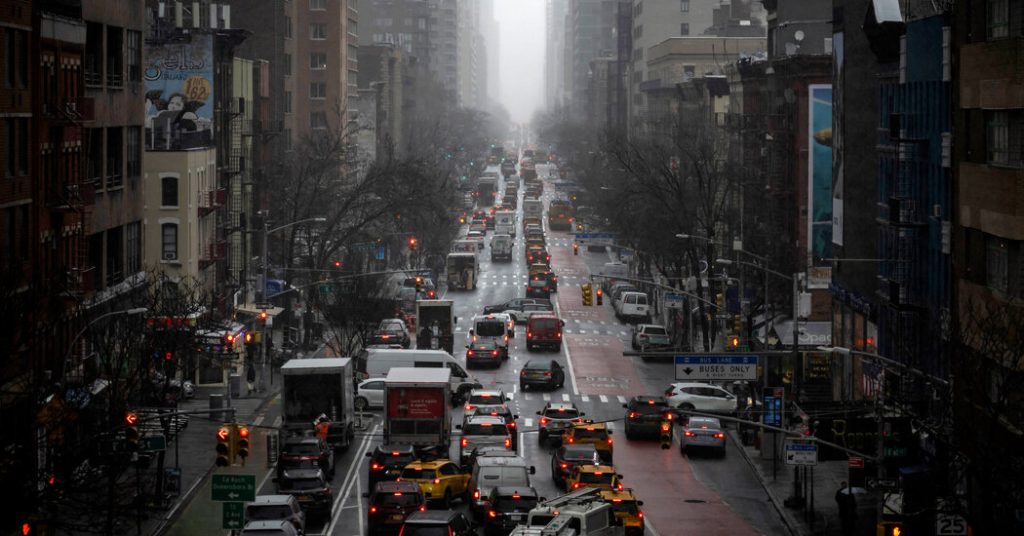President Trump Considers Action Against Congestion Pricing in Manhattan
President Trump has recently expressed his opposition to New York City’s congestion pricing plan, a program designed to reduce traffic in Manhattan and generate funds for public transportation improvements. In an interview with The New York Post, Trump stated that he is considering using the federal Department of Transportation to “kill” the initiative, which he believes is deterring people from visiting Manhattan. While Trump did not provide specific details on how he plans to stop the program, he mentioned possibilities such as withholding federal transportation funds or revoking a key federal authorization to toll drivers. The president also revealed that he has been in discussions with New York Governor Kathy Hochul about the future of congestion pricing, though the exact outcomes of these discussions remain unclear.
Trump’s criticism of congestion pricing is part of a broader effort to oppose policies he believes are harmful to New York City. He also took aim at the city’s bike lanes, which are managed by the New York City Department of Transportation. “They’re dangerous. These bikes go at 20 miles an hour. They’re whacking people,” Trump said, vowing to eliminate the lanes entirely. His comments reflect a stark opposition to urban transportation initiatives that prioritize reducing car dependency and promoting alternative modes of transportation.
Congestion Pricing: A Contested Plan to Reduce Traffic and Fund Transit
At the heart of the debate is New York City’s congestion pricing plan, which charges most vehicles a $9 fee to enter Manhattan below 60th Street. The program, implemented to alleviate traffic congestion and raise billions of dollars for subway, bus, and commuter rail upgrades, has been a contentious issue since its inception. While supporters argue that it has already shown positive results—reducing traffic in the designated zone, increasing public transit use, and speeding up commutes for some—critics like Trump claim it unfairly burdens drivers from outer boroughs and suburbs who lack reliable public transit options.
Governor Kathy Hochul has been a strong advocate for congestion pricing, despite initial hesitation when she first took office. She has emphasized its importance for the future of New York City, particularly as the region seeks to modernize its aging transportation infrastructure. However, her support has not been without challenges. New Jersey Governor Philip D. Murphy, a Democrat, has been a vocal opponent of the plan, calling it “a disaster for working- and middle-class New Jersey commuters and residents” in a letter to Trump. Murphy’s opposition highlights the regional implications of the policy, as many commuters from New Jersey rely on driving into Manhattan for work.
Federal and State Tensions Over the Program
The conflict over congestion pricing has also drawn in federal and state officials, with Trump’s administration weighing in on the issue. Among the options Trump could pursue to dismantle the program are revoking federal funding for transportation projects or reopening the environmental review process for the initiative. These actions could significantly delay or halt the program’s implementation. Staff-level discussions between Hochul’s office and the White House have continued, with the governor’s team presenting data to demonstrate the program’s effectiveness. Despite these efforts, the White House has not publicly commented on the matter.
Opposition and Support: A Divided Response
The debate over congestion pricing has sparked a divided response, with criticism coming from both Republican and Democratic officials. Representative Nicole Malliotakis of Staten Island and southern Brooklyn, the only Republican member of New York City’s congressional delegation, expressed her approval of Trump’s efforts to “end this unfair congestion tax.” Malliotakis argued that her constituents are being “double-tolled” for driving into the city, a claim that reflects the concerns of many outer-borough residents who rely on cars for commuting.
On the other hand, advocates for public transportation, such as Riders Alliance spokesman Danny Pearlstein, have defended the program, pointing to its successful track record in court. Pearlstein noted that congestion pricing has been upheld in multiple legal challenges because it underwent rigorous vetting by federal agencies. He emphasized that reversing the program would be difficult, given its strong legal and environmental foundations.
The Broader Implications of the Debate
The debate over congestion pricing reflects a larger conversation about the future of urban transportation and the role of government in addressing infrastructure challenges. While Trump’s opposition to the plan is driven by concerns about its impact on drivers and businesses, supporters argue that it is a necessary step toward reducing traffic, improving air quality, and modernizing public transit systems. The outcome of this debate will have far-reaching implications not only for New York City but also for other urban areas considering similar congestion pricing models.
Ultimately, the fate of New York’s congestion pricing plan rests on the interplay between federal and state policies, legal challenges, and public opinion. As the discussion continues, it remains to be seen whether Trump’s efforts to dismantle the program will succeed or if the program will endure as a key component of New York’s transportation strategy. One thing is clear: the battle over congestion pricing is as much about the future of urban mobility as it is about political will and the balance of power in shaping the city’s infrastructure.












